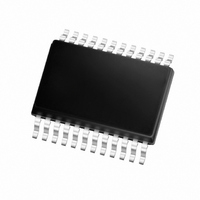MCP3909-I/SS Microchip Technology, MCP3909-I/SS Datasheet - Page 98

MCP3909-I/SS
Manufacturer Part Number
MCP3909-I/SS
Description
IC POWER METERING-1 PHASE 24SSOP
Manufacturer
Microchip Technology
Datasheets
1.MCP3909T-ISS.pdf
(44 pages)
2.MCP3909T-ISS.pdf
(104 pages)
3.MCP3909-ISS.pdf
(40 pages)
Specifications of MCP3909-I/SS
Package / Case
24-SSOP (0.200", 5.30mm Width)
Input Impedance
390 KOhm
Measurement Error
0.1%
Voltage - I/o High
2.4V
Voltage - I/o Low
0.85V
Current - Supply
2.3mA
Voltage - Supply
4.5 V ~ 5.5 V
Operating Temperature
-40°C ~ 85°C
Mounting Type
Surface Mount
Meter Type
Single Phase
Operating Temperature Range
- 40 C to + 85 C
Mounting Style
SMD/SMT
Supply Voltage Range
4.5V To 5.5V
Digital Ic Case Style
SSOP
No. Of Pins
24
Interface Type
Serial, SPI
Supply Voltage Max
5.5V
Rohs Compliant
Yes
Lead Free Status / RoHS Status
Lead free / RoHS Compliant
For Use With
MCP3909EV-MCU16 - EVALUATION BOARD FOR MCP3909MCP3909RD-3PH1 - REF DESIGN MCP3909 3PH ENGY MTR
Lead Free Status / Rohs Status
Lead free / RoHS Compliant
Available stocks
Company
Part Number
Manufacturer
Quantity
Price
Part Number:
MCP3909-I/SS
Manufacturer:
MICROCHIP/微芯
Quantity:
20 000
MCP3909 / dsPIC33F 3-Phase Energy Meter Reference Design
C.16 PHASE LAG COMPENSATION
DS51723A-page 98
Phase lag of a CT has no effect on the metering of RMS current/voltage and apparent
power, but will affect the metering of power, since the phase lag will change the phase
relationship between the input current and the voltage. This will result in a deviation of
the calculated active power from the calculated reactive power.
Figure C-10 shows how a transformer's phase lag affects the measured results under
both inductive and capacitive loads. Let's assume that the output of CT has no phase
lag from the input voltage, while the CT has a phase lag from the input signal. With
inductive loads, the phase angle increases between the volatge and the current
because of the phase lag induced by the CT, resulting in a decrease of the measured
active power and an increase of the reactive power. While with capacitive loads, the
phase angle between the voltage and the current decreases because of the phase lag
induced by the CT, resulting in a decrease of the measured reactive power and an
increase of active power.
There are many methods for phase lag compensation. In this design the result correc-
tion method is used. It compensates with a coefficient after the active power and
reactive power are figured out, which has a small amount of calculation.
FIGURE C-10:
Assuming that the phase lag of CT is ϕ
phase lag between current and voltage is:
FIGURE C-11:
Inductive
Capacitive
Load
Load
θ
Δθ
Measurement Change Caused By Transformer Phase Lag.
Principle Of Phase Lag Correction.
Δf
CT Output
current
current
voltage
Input
Input
F
S
P'
P
i
, of PT is ϕ
Δϕ
=
ϕ
u
–
u
, after PT and CT, the variation of
ϕ
Inductive
Capacitive
i
.
Load
Load
Q
© 2009 Microchip Technology Inc.
θ
Q'
Δθ
current
Input
voltage
Input
CT Output
current













